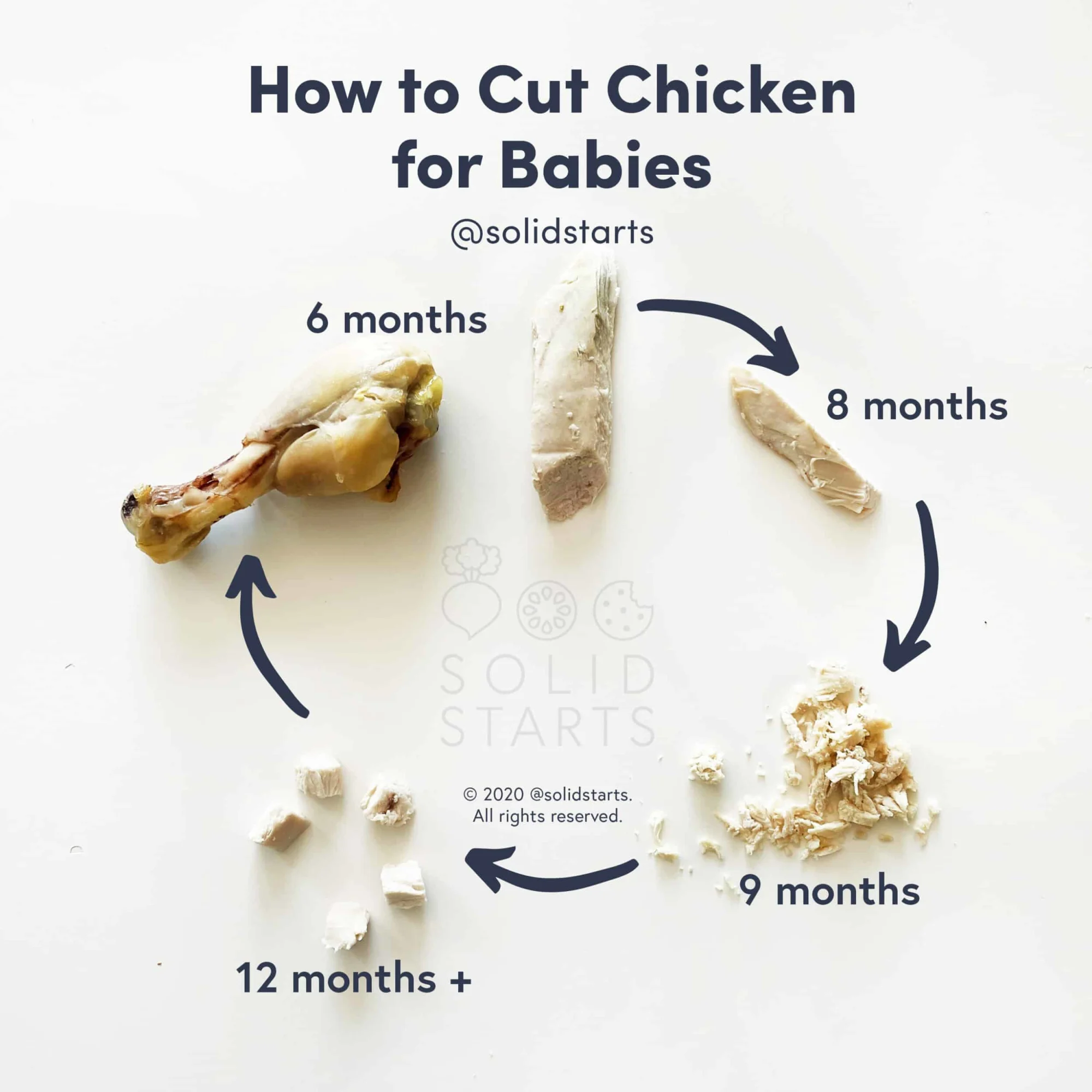Chicken
Meat
Age Suggestion
6 months
Iron-Rich
Yes
Common Allergen
No

When can babies have chicken?
Chicken, when well-cooked, may be introduced as soon as baby is ready to start solids, which is generally around 6 months of age.
Thousands of years ago, humans domesticated a scrawny fowl that had been running wild in the jungles of South Asia since prehistoric times. From that agricultural innovation came the bird we know and love today. Almost the entire chicken can be used to cook delicious dishes, from pâtés of iron-rich chicken liver; to protein-packed stocks filled with collagen from the carcass, feet, and head; to schmaltz, a flavorful fat extracted from the skin.
Is chicken healthy for babies?
Yes. Chicken contains many nutrients that babies need to thrive, including protein and fat, in addition to choline, iron, selenium, and zinc, as well as vitamins B3, B6, and B12. Together, these nutrients support growth, brain development, energy to play and explore, healthy red blood cells, taste perception, immune health, hormone function, metabolic processes, and more.
★ Tip: Chicken is often associated with food-borne illness from bacteria like Salmonella and Campylobacter. Taking the appropriate precautions can minimize the risk: Keep chicken in the refrigerator or freezer—and store it separately from produce. Thaw frozen meat in the refrigerator (never on the counter) and cook chicken to an internal temperature of 165 degrees Fahrenheit (74 degrees Celsius) before serving. Always wash your hands and surfaces that come in contact with the raw meat.
Is chicken a common allergen?
No. Chicken is not a common food allergen. However, cases of poultry allergy have been reported. Chicken has been reported as a trigger for FPIES (Food Protein-Induced Enterocolitis Syndrome), which results in delayed vomiting with or without diarrhea 2 to 4 hours after the ingestion of chicken meat. While rare, certain individuals with fish allergies may have an increased risk of being sensitive to chicken. Some individuals with known allergy to feather and egg also have positive allergy test results to chicken meat. However, this does not commonly result in symptoms after the ingestion of well-cooked meat, as the allergenic protein is heat sensitive. Therefore, routine testing for chicken meat allergy is not recommended in cases of egg allergy.
As you would when introducing any new food, start by offering a small quantity during the first few servings. If there is no adverse reaction, gradually increase the amount over future meals.
Is chicken a choking hazard for babies?
Yes. Like all meat and poultry, chicken is a choking hazard, so avoid offering large chunks or cubes to babies. To minimize the risk, refrain from cutting chicken in cubes and prepare and serve it in an age-appropriate way as described in the How to Serve section. Also, be sure not to overcook chicken as this causes it to be dry and more challenging to chew and swallow. As always, make sure you create a safe eating environment and stay within an arm’s reach of baby during meals.
Learn the signs of choking and gagging and more about choking first aid in our free guides, Infant Rescue and Toddler Rescue.
Videos
Can babies eat chicken nuggets?
Yes. While chicken nuggets are typically high in sodium, an occasional taste as part of a varied diet is fine as long as they are modified to reduce choking risk. If the chicken nuggets have a very firm, crunchy exterior, consider peeling off the coating before serving or waiting until closer to 18 months to serve, when most toddlers will have the molars to manage more challenging textures. For babies 9 months and up, you can offer bite-sized pieces or thin slices of chicken nuggets as long as they are soft and not too crunchy. After the first birthday, you can try serving soft, whole chicken nuggets for practice taking bites.
How do you serve chicken to babies?
Every baby develops on their own timeline, and the suggestions on how to cut or prepare particular foods are generalizations for a broad audience.
6 months old +:
Serve a whole, well-cooked drumstick with the skin and any pieces of loose cartilage and fat removed. Babies love to pick up and munch on drumsticks—and it is fantastic for oral-motor skills. Baby will not likely consume much, and this is okay. If a big piece of meat is torn off, give baby time to work with the food before intervening. Babies have innate reflexes at this age to help keep the airway safe and reduce choking risk. Worried about the slender bone that runs alongside the main drumstick bone? Try not to be. Babies typically do not have the jaw strength or biting skill to expose this tiny bone, which is called pin bone. If you notice that baby tends to bite off enough of the meat to expose the pin bone, consider removing all of the meat, cartilage, and pin bone and offer just the main drumstick bone as a food teether. Keep in mind that chicken drumsticks, depending on how they're cooked, can become brittle and easily breakable, especially at the edges. We recommend checking and testing the bone prior to offering by trying to bend it and pushing on the edges. Strong, firm bones are the way to go. If the bone breaks easily, crumbles at the edges, or splinters, the risk for bone to break off in baby’s mouth increases. Stewing or slow cooking chicken drumsticks at a lower temperature can help minimize brittle bones while ensuring they are fully cooked.
In addition to drumsticks, you can serve chicken sliced into long, flat strips about the size of two adult fingers pressed together. Alternatively, offer shredded chicken that has been mixed into a soft, scoopable food like mashed vegetables. You can also serve meatballs or meatloaf made from ground chicken; just make sure the food is fully cooked to 165 F (74 C), soft enough that it mashes between your thumb and pointer finger, and larger than baby’s mouth.
9 months old +:
When you see signs of a developing pincer grasp (when the thumb and pointer finger meet), you can move down in size. Offer shredded chicken, thinly sliced chicken, or bite-sized pieces of chicken meatball or meatloaf for baby to practice picking up. As babies get better at picking up small pieces, they may start stuffing or shoveling food into the mouth. While this is an opportunity for learning what "too much" feels like, it can be quite stressful to watch happen. If this occurs, you can offer fewer pieces of food at a time and coach the child how to spit out food. You can also continue to offer a chicken drumstick as long as any loose pieces of cartilage and fat have been removed. At this age, babies are more likely to bite off pieces of meat from the drumstick, which is great practice with managing the food. If baby is consistently struggling with big pieces of food in the mouth or biting into the pin bone, remove all the meat and just offer the drumstick bone as a food teether for now. When preparing chicken, make sure it is fully cooked to 165 F (74 C), and ground chicken crumbles, meatballs, or meatloaf are soft enough to easily mash with gentle pressure. Cooking ground chicken in sauce or stew or mixing breadcrumbs, egg, and/or milk into meatball or meatloaf can help keep them soft.
12 months old +:
Offer bite-sized pieces of chicken as finger food or let the toddler practice with a utensil. To reduce the risk of choking, refrain from offering chunks of chicken or serving perfectly sized cubes. A chicken drumstick (loose cartilage and fat removed) is also a great finger food at this age, either with the meat for biting and tearing practice or with the meat removed so the bone acts as a food teether.


Removing skin from a chicken drumstick.
Removing skin from the knuckle
Take the stress out of day-to-day cooking with our Meal & Recipe Ideas Kit.
Our Team
Written by
Expert Tips Delivered to Your Inbox
Sign up for weekly tips, recipes and more!
Copyright © 2024 • Solid Starts Inc







